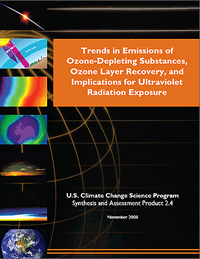Final CCSP Report on Trends in Emissions of Ozone-depleting Substances, Ozone Layer Recovery, and Implications for Ultraviolet Radiation Exposure
November 13, 2008A new NOAA-led assessment of the global ozone layer says the U.S. has reduced by 97-98 percent the production of ozone damaging substances since the late 1980s. The assessment is one in a series of synthesis and assessment reports coordinated by the U.S. Climate Change Science Program.
The report also offers a glimpse into expectations for recovery of the ozone layer in a changing climate, as well as the first detailed look at U.S. role in emitting — and reducing the emissions of — the chemicals that deplete the ozone layer. The ozone layer, which surrounds the globe about 10-15 miles above the surface, protects living things from the sun’s harmful ultraviolet rays.
”With the efforts of the U.S. and the over 190 nations in the Montreal Protocol, we have avoided a future world of higher ozone depletion and exposure of humans and other living things to unhealthy levels of ultraviolet radiation,” said A.R. Ravishankara, NOAA atmospheric chemist and lead author on the new report.
The report finds that U.S. production and use of ozone-depleting substances have been significant throughout the history of this issue, contributing about 25 percent of the global amount produced during the period from 1986 to 1994.
By adopting the 1987 international Montreal Protocol agreement to protect the ozone layer, the U.S. has also contributed to significant healing of the ozone layer by reducing the production and use of ozone-depleting substances, according to the report. The U.S. percentage of the global total production has fallen to 10 percent in recent years.
The numbers reflect a decline of 97-98 percent in the U.S. production of the ozone-damaging chemicals since the late 1980s. U.S. actions have aided international efforts to achieve a recovery of the ozone layer, which is expected to occur about mid-century for most regions of the globe. Ozone depletion is not worsening, and in some regions the ozone layer is now showing early signs of recovery.
The ozone layer is recovering largely because of the actions taken by the international community to limit ozone-depleting substances, such as chlorofluorocarbons, or CFCs, that were used as coolants in refrigerators and air conditioning systems. The Montreal Protocol and its subsequent amendments established limits and eventual phase-outs for production and consumption of several ozone-depleting substances.
As the report notes, without the Montreal Protocol, the levels of ozone-depleting substances in the “world we avoided” would likely have been 50 percent larger in 2010 than currently predicted.
Most individuals are familiar with the annual “ozone hole” that occurs over Antarctica. Scientists, including those from NOAA, discovered that human-made substances take part in chemical reactions in the unique Antarctic environment to cause a large recurring springtime depletion, or “hole,” in the very thin layer of ozone in the stratosphere above Antarctica. Smaller depletions of the ozone layer have been observed in other regions of the globe.
The report was written by a team of 16 scientists from six different federal agencies. They developed information for and about the U.S., and drew material from two recent international scientific assessment reports to which the U.S. contributed, to distill a U.S.-specific perspective on this global issue.
The full Climate Change Science Program report, Trends in Emissions of Ozone-Depleting Substances, Ozone Layer Recovery, and Implications for Ultraviolet Radiation Exposure, and a summary brochure are available online.
NOAA plays a key role in the Climate Change Science Program, which is responsible for coordinating and integrating climate research, observations, decision support, and communications of 13 federal departments and agencies.

